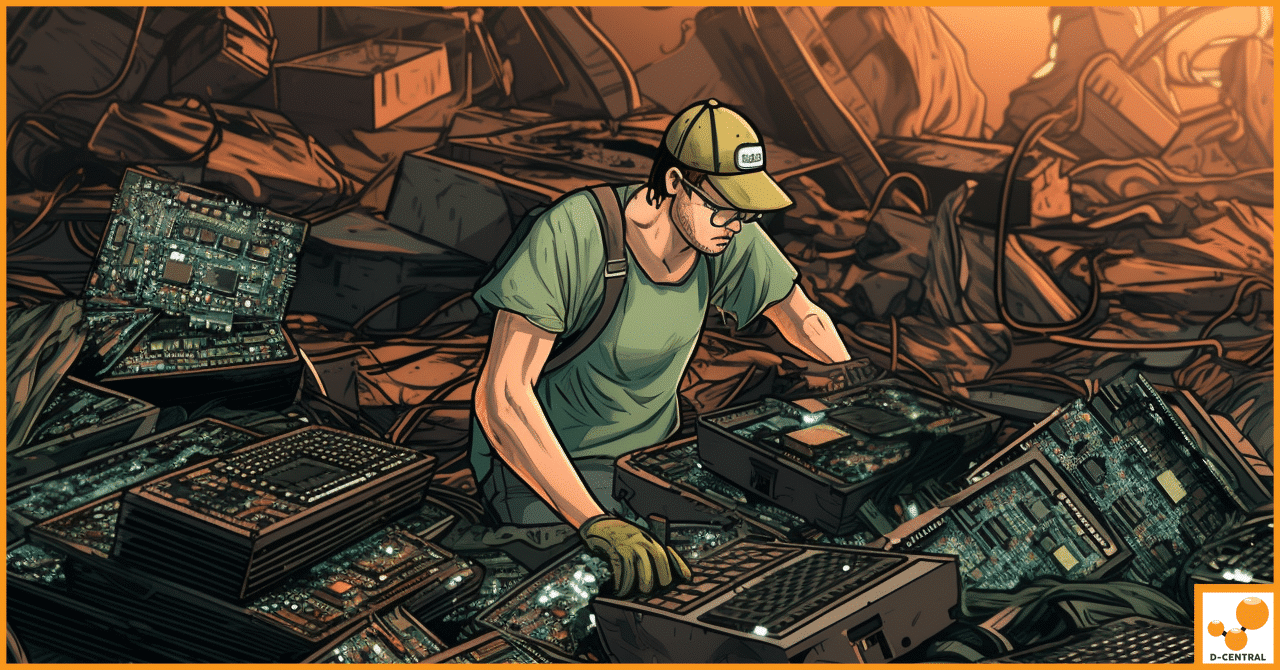
Bitcoin Mining: The Tireless Engine of the Bitcoin Network
Bitcoin mining is the process of validating transactions and securing the Bitcoin network by solving complex mathematical puzzles. As a
4479 Desserte Nord Autoroute 440, Laval, QC H7P 6E2

As the world becomes increasingly conscious of the environmental impact of various industries, eco-friendly mining is becoming more important than ever. In the realm of cryptocurrency mining, the push for sustainability is vital, as traditional mining methods can have significant negative effects on the environment. One solution to this issue is Antminer refurbishment, a process that helps reduce e-waste and promote sustainable mining practices.
In this article, we will explore the environmental impact of traditional cryptocurrency mining and discuss the concept of e-waste and its consequences. Following this, we will delve into Antminer refurbishment as a solution for e-waste reduction and discuss sustainable mining practices, renewable energy, energy-efficient mining technologies, mining optimization, resource management, and recycling in the mining industry. Additionally, we will explore the role of environmental responsibility in this sector and speculate about the future of eco-friendly mining and Antminer refurbishment.
Cryptocurrency mining has been a popular and lucrative activity for many individuals and organizations worldwide. However, the traditional mining methods, which rely on vast amounts of energy and non-renewable resources, can have severe repercussions on the environment. One of the primary concerns is the mining power consumption, which is responsible for a significant portion of the global carbon footprint.
Furthermore, the production and disposal of mining hardware contribute to the ever-growing issue of electronic waste, or e-waste. As mining equipment becomes obsolete or reaches the end of its lifecycle, it often ends up in landfills, leading to pollution and harmful consequences for both the environment and human health. This waste of valuable resources highlights the need for more sustainable mining practices and the importance of adopting eco-friendly mining methods.
E-waste refers to the discarded electronic devices and components that have reached the end of their useful life. With the rapid advancement of technology, the volume of e-waste has been increasing at an alarming rate, posing significant environmental and health risks. Inadequate electronic waste management leads to the leakage of hazardous substances into the soil, air, and water, impacting ecosystems and human health.
Moreover, e-waste contains valuable resources such as precious metals, which can be extracted and reused if managed correctly. Unfortunately, many countries lack proper regulations and infrastructure for e-waste management, leading to improper disposal and missed opportunities for resource recovery. Considering the environmental and health implications of e-waste, it is crucial to explore methods for reducing the generation of electronic waste and promoting sustainable practices in the mining industry.
Antminer refurbishment is a process that involves repairing, upgrading, and repurposing mining hardware to extend its lifespan and improve its performance. This practice helps reduce e-waste by allowing miners to continue using their equipment instead of disposing of it and purchasing new devices. Furthermore, refurbishing mining equipment can lead to improved mining efficiency and reduced power consumption, contributing to a smaller carbon footprint and environmental impact.
By choosing to refurbish their Antminers, mining operators can save money on new equipment, reduce their environmental impact, and contribute to the circular economy. This eco-friendly approach to mining equipment management is gaining traction within the industry as more companies recognize the benefits of adopting sustainable practices.
Sustainable mining practices encompass a wide range of strategies and techniques aimed at reducing the environmental impact of mining activities. These practices can include adopting energy-efficient mining technologies, using renewable energy sources, optimizing mining operations, and implementing responsible resource management.
One of the most significant benefits of sustainable mining practices is the reduction of the industry’s carbon footprint. By utilizing energy-efficient technologies and renewable energy, mining operations can significantly reduce their greenhouse gas emissions and contribute to global efforts to combat climate change. Additionally, sustainable mining practices can lead to cost savings for mining operators as they reduce energy consumption, extend the life of mining equipment, and minimize waste generation.
Furthermore, adopting sustainable mining practices can improve the industry’s overall image and public perception. As environmental concerns become more prevalent in society, mining operators that prioritize sustainability and eco-friendly practices are likely to gain a competitive edge and attract environmentally conscious investors and customers.
A critical aspect of eco-friendly mining is the adoption of renewable energy sources and energy-efficient mining technologies. Renewable energy, such as solar, wind, and hydropower, can be harnessed to power mining operations, reducing the reliance on fossil fuels and lowering greenhouse gas emissions. By transitioning to renewable energy, mining operators can significantly reduce their carbon footprint and contribute to global efforts to combat climate change.
Energy-efficient mining technologies are designed to optimize the mining process and reduce power consumption. These technologies can include advanced mining algorithms, improved cooling systems, and hardware innovations that minimize energy use without sacrificing performance. By adopting energy-efficient technologies, mining operations can achieve higher efficiency while reducing their environmental impact.
Mining optimization involves refining mining operations to increase efficiency, reduce waste, and minimize the environmental impact. This can include adjusting mining algorithms, implementing automation, and optimizing the use of resources such as water, energy, and raw materials.
Resource management is a crucial component of sustainable mining practices, as it involves the responsible utilization and conservation of resources throughout the mining process. This can include recycling water, minimizing energy consumption, and reducing waste generation. By implementing effective resource management strategies, mining operators can minimize their environmental impact and contribute to a more sustainable industry.
The refurbishing and recycling of mining equipment play an essential role in promoting sustainability and reducing e-waste in the mining industry. As mentioned earlier, Antminer refurbishment is a process that involves repairing, upgrading, and repurposing mining hardware to extend its lifespan and improve its performance. This practice helps reduce e-waste and contributes to a more sustainable mining industry.
In addition to refurbishing equipment, mining operators can implement recycling programs to recover valuable materials from obsolete or end-of-life hardware. This can include extracting precious metals, reusing components, or recycling materials for use in new products. By adopting recycling practices, mining operators can reduce waste, conserve resources, and contribute to the circular economy.
Environmental responsibility is becoming increasingly important in the mining industry, as companies and individuals recognize the need to minimize their impact on the environment and adopt sustainable practices. This responsibility extends beyond legal compliance and involves a commitment to reducing waste, conserving resources, and mitigating the environmental impact of mining activities.
By prioritizing environmental responsibility, mining operators can demonstrate their commitment to sustainability and improve their industry’s public perception. This can lead to increased investor interest, customer loyalty, and a competitive advantage in the market. Additionally, environmentally responsible companies are more likely to attract top talent, as employees increasingly seek out employers that share their values and prioritize sustainability.
The future of eco-friendly mining looks promising, as more companies and individuals recognize the need for sustainability and adopt environmentally responsible practices. This shift towards eco-friendly mining is likely to lead to advancements in energy-efficient technologies, renewable energy integration, and innovative solutions for reducing waste and conserving resources.
Antminer refurbishment will continue to play a vital role in combating e-waste and promoting sustainable mining practices. As awareness of the environmental impact of mining grows, we can expect tosee more companies and individuals turning to Antminer refurbishment as a cost-effective and eco-friendly alternative to purchasing new mining equipment.
Furthermore, the increasing demand for sustainable mining practices is likely to lead to industry-wide changes, such as the development of new technologies and the implementation of stricter environmental regulations. These changes will create new opportunities for innovation and growth within the industry, as companies strive to meet the growing demand for eco-friendly mining solutions.
Eco-friendly mining is becoming increasingly important, as the environmental impact of traditional mining methods becomes more apparent. Antminer refurbishment offers a cost-effective and sustainable solution to reducing e-waste and promoting responsible mining practices.
By adopting sustainable mining practices, utilizing renewable energy, optimizing mining operations, and implementing resource management strategies, the mining industry can significantly reduce its environmental impact and contribute to global efforts to combat climate change.
As the industry continues to shift towards sustainability, we can expect to see further advancements in energy-efficient technologies, renewable energy integration, and innovative solutions for reducing waste and conserving resources. By prioritizing environmental responsibility and adopting eco-friendly mining practices, the mining industry can create a more sustainable future for all.
Q: What is the environmental impact of traditional cryptocurrency mining?
A: Traditional cryptocurrency mining methods rely on vast amounts of energy and non-renewable resources, which can have severe repercussions on the environment. The primary concerns are the mining power consumption, which contributes significantly to the global carbon footprint, and the production and disposal of mining hardware, which contributes to the ever-growing issue of electronic waste (e-waste).
Q: What is e-waste and its consequences?
A: E-waste refers to the discarded electronic devices and components that have reached the end of their useful life. It has been increasing at an alarming rate, posing significant environmental and health risks. Inadequate electronic waste management leads to the leakage of hazardous substances into the soil, air, and water, impacting ecosystems and human health. Moreover, e-waste contains valuable resources, such as precious metals, which can be extracted and reused if managed correctly.
Q: How does Antminer refurbishment help in reducing e-waste?
A: Antminer refurbishment is a process that involves repairing, upgrading, and repurposing mining hardware to extend its lifespan and improve its performance. This practice helps reduce e-waste by allowing miners to continue using their equipment instead of disposing of it and purchasing new devices. Furthermore, refurbishing mining equipment can lead to improved mining efficiency and reduced power consumption, contributing to a smaller carbon footprint and environmental impact.
Q: What are the benefits of sustainable mining practices?
A: Sustainable mining practices reduce the industry’s carbon footprint by utilizing energy-efficient technologies and renewable energy. These practices can lead to cost savings for mining operators by reducing energy consumption, extending the life of mining equipment, and minimizing waste generation. Additionally, sustainable mining practices can improve the industry’s overall image and public perception, helping environmentally conscious companies gain a competitive edge and attract investors and customers.
Q: How can renewable energy and energy-efficient mining technologies be integrated into eco-friendly mining?
A: Renewable energy sources, such as solar, wind, and hydropower, can be harnessed to power mining operations, reducing the reliance on fossil fuels and lowering greenhouse gas emissions. By transitioning to renewable energy, mining operators can significantly reduce their carbon footprint. Energy-efficient mining technologies optimize the mining process and reduce power consumption, allowing mining operations to achieve higher efficiency while reducing their environmental impact.
Q: What role does environmental responsibility play in the mining industry?
A: Environmental responsibility is becoming increasingly important in the mining industry as companies and individuals recognize the need to minimize their impact on the environment and adopt sustainable practices. This responsibility extends beyond legal compliance and involves a commitment to reducing waste, conserving resources, and mitigating the environmental impact of mining activities. By prioritizing environmental responsibility, mining operators can demonstrate their commitment to sustainability, improve their industry’s public perception, and gain a competitive advantage in the market.
Q: What is the future of eco-friendly mining and Antminer refurbishment?
A: The future of eco-friendly mining looks promising as more companies and individuals recognize the need for sustainability and adopt environmentally responsible practices. Antminer refurbishment will continue to play a vital role in combating e-waste and promoting sustainable mining practices. The increasing demand for sustainable mining practices is likely to lead to advancements in energy-efficient technologies, renewable energy integration, and innovative solutions for reducing waste and conserving resources.
DISCLAIMER: D-Central Technologies and its associated content, including this blog, do not serve as financial advisors or official investment advisors. The insights and opinions shared here or by any guests featured in our content are provided purely for informational and educational purposes. Such communications should not be interpreted as financial, investment, legal, tax, or any form of specific advice. We are committed to advancing the knowledge and understanding of Bitcoin and its potential impact on society. However, we urge our community to proceed with caution and informed judgment in all related endeavors.
Related Posts

Bitcoin mining is the process of validating transactions and securing the Bitcoin network by solving complex mathematical puzzles. As a

n the intricate world of Bitcoin mining, Application-Specific Integrated Circuit (ASIC) miners stand as the backbone of the industry, driving

In the ever-evolving landscape of cryptocurrency, Bitcoin mining emerges as a cornerstone activity, underpinning the decentralized ethos of digital currency.